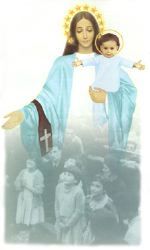“This is Your Mother.”
Fr. Joseph A. Pelletier, A.A.
From: Mary Our Mother: Reflections of the Message of Garabandal
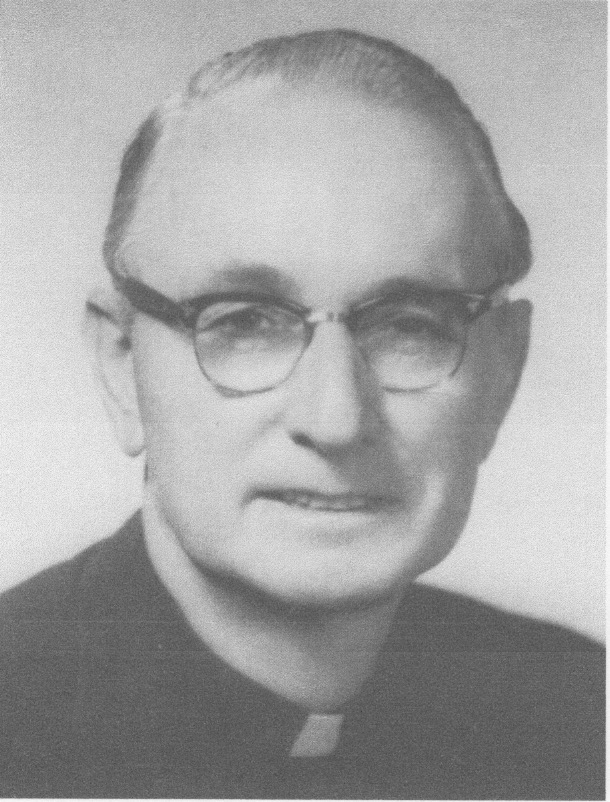
In a sense the Church has lost Mary since Vatican II. This is truly a strange turn of events, when we consider the man who called the Council, Pope John. He took Mary as his mother from the earliest days of his childhood and never ceased to clasp her to his heart. But the Church can never completely lose anything truly authentic. She has not really lost Mary. The Holy Spirit kept the embers of her spiritual motherhood alive in the hearts of men. Love of her lies deep in the Christian soul and is never completely snuffed out. It waits there to be called forth and it responds enthusiastically to the call. This was the author’s rewarding experience as he lectured extensively in the United States, Ireland, England and Scotland on the message of Garabandal. These pages are reflections on a vital point in that message, one the world hungers and thirsts for, namely, that Mary is our spiritual mother. Jesus told us through John: “This is Your Mother†(Jn 19:27).
Spiritual Poison and a Heavenly Antidote
Marian devotion in the Church was greatly shaken and was even uprooted from many hearts as an unforseen and unwanted by-product of Vatican Council II. This was certainly not the desire or intention of the great Marian Pope,John XXIII. When he called the Council, he made a pilgrimage to Loretto to place it under Our Lady’s special protection. Every page of his spiritual diary, Journal of a Soul, breathes Mary. No book of our time bears greater personal witness to devotion to the rosary than this one.
That, in great part, is what Garabandal is about: finding Mary again, restoring her to her God given place in our lives and in the Church. God foresaw all that would happen after Vatican II concerning Mary. He knew the poison this would be for us. So he gave us an antidote before the poisoning of minds and hearts took place. The antidote was Garabandal. It was there, standing ready for use, when the poison was poured out in so many insidious ways.
A Witness to God’s Love and Mary’s Motherly Concern
People say, “We don’t need Garabandal, we have Lourdes and Fatima.†By saying this, they show they do not understand the fundamental reality behind these events. Such events are a witness, a witness to God’s love for his People and to Mary’s motherly concern for her children. We need a manifestation of heaven’s lively interest in us in times of crisis, and who could deny that we are in a crisis. Fatima came at a time of crisis, in 1917, during World War 1 and at the very moment when Communism was making its first solid foothold in a country.
The testimony of the event itself, of the happening represented by the apparitions, the evidence of the divine intervention, is every bit as important a message as the verbal message given at a place like Lourdes, Fatima and Garabandal Indeed, the spoken message in its essential parts is never more than a reminder of the gospel, of things that we already know or should know. The predictions sometimes contained in such heavenly messages are always very secondary.
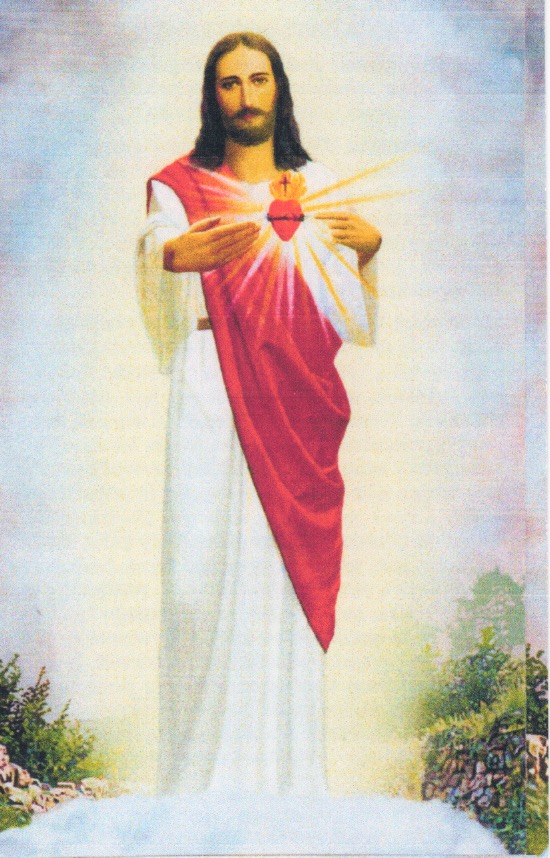
So, although it may seem to some that the Church is falling apart, it is not; and that God is dead, he is not. He is very much alive and concerned about his Church. He came to Garabandal to speak to us about it. One thing that he wants us to know is that Mary has not suddenly been eliminated from his plan for us. He knows how stiff-necked we are and how slow to understand. He sent Mary two thousand times to speak to us in his name at Garabandal. He loves us. He wanted to be sure we would get this message about his love for us and that Mary is our mother.
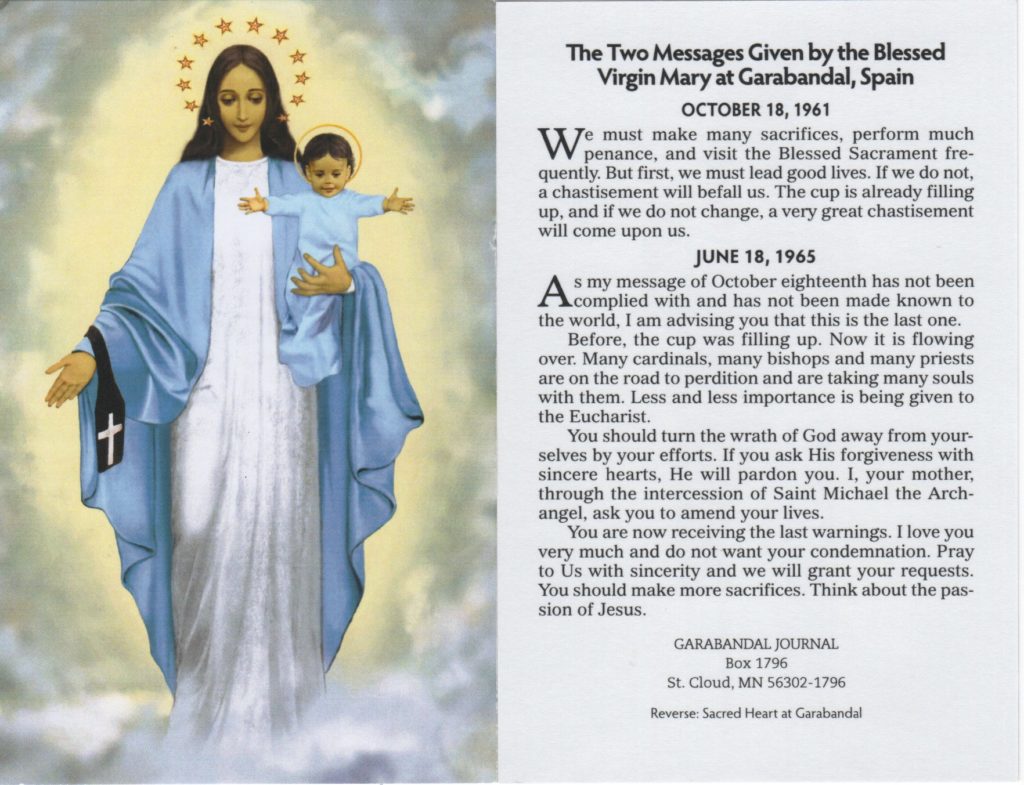
The Marian Message of Garabandal
The Garabandal message is mainly a Marian message. Yet mention of Mary was not included explicitly in what Our Lady herself called the “messages,†in 1961 and 1965. The Marian part of the message emphasizes several things: devotion to Mary based on her spiritual motherhood, and then the two major traditional forms of devotion to her, the brown scapular and the rosary. Mary’s motherhood was taught in words, events and things. The choice of the feast of the Visitation for her first apparition, and the kissing of objects during her final apparition were instances of this teaching through events and things.
God Speaks through the Choice of His Messenger
Mary is our Mother. This is the first message of Garabandal, expressed subtly through God’s choice of Mary as his principal messenger. God speaks powerfully to his People through his actions. So it was in Old Testament times. God spoke to his People then of his Jove and protection through his mighty works: the deliverance of Israel from Egypt, the passage through the Red Sea, the column of fire, the manna, and the water flowing from the rock in the desert, etc. So, too, it was during Christ’s lifetime. Jesus’ actions and miracles had a symbolic meaning, a lesson to impart to us, from his virginal conception and birth in a manger through the changing of water into wine at Cana to the flowing of water and blood from his side on the cross. And, so also it happens in the Church. God speaks to his People through his works, particularly through special interventions in history. In recent times, he spoke to us at Lourdes and at Fatima. And now in our own day, he speaks to us at Garabandal. The primary message at all three places was that of Mary’s continuing role as mother of his People, of the Church. He sent her to remind us of her special role under his Son, in the redemption of mankind.
He knew men would quickly forget Pope John who had such outstanding love for her and who prayed the rosary every day with great confidence. He knew that the discussion about Mary at Vatican II would be exploited by the evil one, the father of lies, the great deceiver and that he would work great harm. He knew that the outstanding chapter on Mary in The Constitution on the Church, with its admirable summary of the traditional Marian doctrine, would be read and preached by few. So God took steps, using his own powerful methods to assure us that she is no less our mother today than at the Annunciation when she freely and gladly gave the consent which began our salvation, or when Christ proclaimed her our mother from the cross. He sent her to Garabandal in 1961, a year before the Council. He sent her a surprising number of times. He surrounded her visits with an almost unbelievable abundance of extraordinary phenomena, to attract our attention and to prove that his hand was working there.
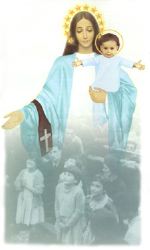
Mary is a Stumbling Block for the Proud
He was telling us the same simple message as before: Mary is your mother, as my Son told you on Calvary. You need her help. I have given her a special role, fully dependent upon my Son, in the working out of my redemptive plan. I want you to recognize my will in her regard and to acknowledge the exceptional role I have freely chosen to confide to her, for your sake. I am not pleased when men, in the pride of the hearts, refuse to accept my plan; when they reject my designs simply because these do not suit their thinking. When will they learn and humbly acknowledge that my ways are not theirs? “The Lord knows how empty are the thoughts of the wise†(I Cor 3:20).
The wise men of this world will never understand Mary. She will always be a stumbling block to their pride, a folly to them in their self-complacent wisdom. Only the meek and humble of heart will believe and accept the amazing and exalted position God wants Mary to have.
Fr. Joseph A. Pelletier, A.A


